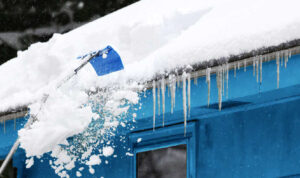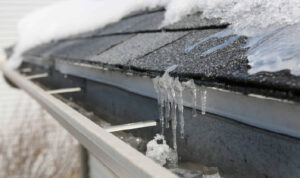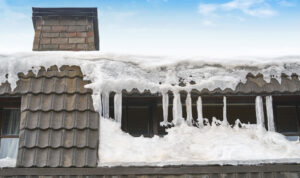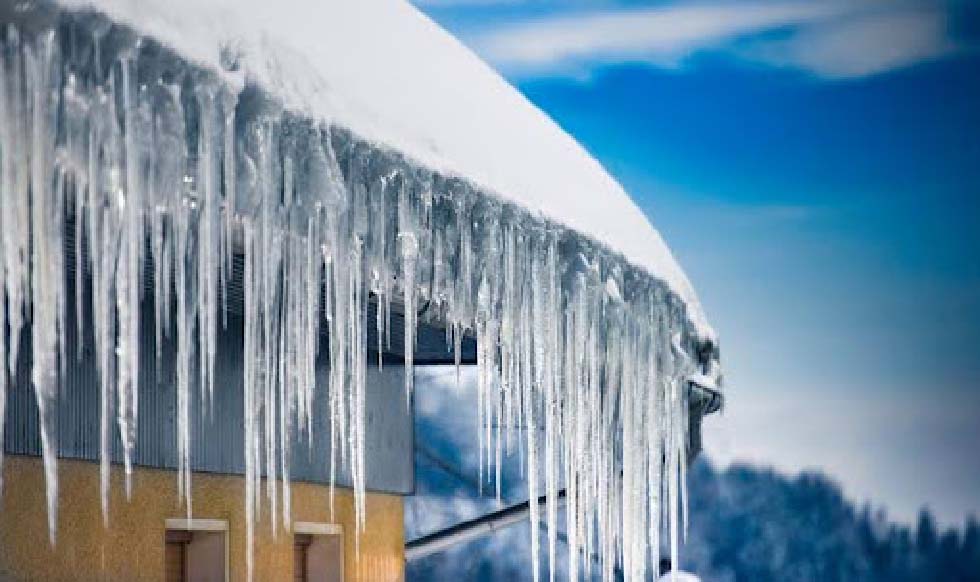Common Roof Problems Caused by Snow and Ice Accumulation
Winter’s serene beauty often hides the potential dangers it brings to your home. While snow-covered rooftops create a picturesque scene, the weight and moisture buildup can silently compromise your roof’s integrity. As snow and ice accumulate, they can lead to a variety of issues, including leaks, structural strain, and costly damage. Ignoring these risks could turn your warm and cozy retreat into an unexpected headache. Understanding these common winter roofing problems can help you take proactive steps to protect your home.

Understanding the Risks of Winter Weather on Your Roof
Snow Load on Roof: The Silent Danger
Snow on a roof isn’t just a nuisance—it can be a heavy burden. Snow load, or the amount of weight your roof must support, increases as snow accumulates. A roof that isn’t designed to handle such weight can suffer significant damage, including cracks or even collapse. The challenge with snow load is its gradual effect—it builds over time, making it difficult to notice until it’s too late. This is why regular inspections are crucial in ensuring your roof can handle the snow load safely.
Ice Accumulation on Roof: What It Means for Your Home
Ice accumulation is another winter challenge that homeowners face. When snow melts and refreezes on the roof, it forms ice sheets. Over time, these ice buildups, called ice dams, can prevent proper drainage, leading to water backing up under shingles and causing leaks inside your home. The weight of the ice itself can also put pressure on your roof, leading to potential cracks or even holes if not addressed promptly.
How Snow and Ice Cause Roof Leaks in Winter
The Process Behind Roof Leaks During Winter
Roof leaks in winter are often a result of ice dams or poorly insulated attics. As heat escapes from your home, it melts the snow on the roof, and the water flows down to the colder eaves. There, it refreezes, forming an ice dam. The trapped water behind this dam can seep under shingles, causing leaks and water damage inside your home. A simple leak can lead to significant problems like mold, wood rot, and damaged insulation, which can cost a fortune to repair.
Preventing Water Damage from Roof Leaks
Preventing roof leaks begins with proper insulation and ventilation. By ensuring your attic is well-insulated, you can prevent the snow from melting unevenly. Adequate ventilation also helps to maintain an even temperature across your roof, reducing the risk of ice dams. Regular inspections of your roof and gutters can also prevent ice from causing permanent damage.
Icicles and Ice Dams: A Beautiful Yet Dangerous Sight
What Are Ice Dams and How Do They Form?
Icicles hanging from the edge of your roof may look beautiful, but they signal the formation of ice dams. When snow melts, the water travels down to the colder edge of the roof, where it refreezes. Over time, this process builds up ice layers, which block water from draining off the roof, creating dangerous pools of water that can seep into your home.
The Perils of Ice Dams on Your Roof
Ice dams are more than just a cosmetic issue. They can lead to serious roof damage, from leaks to compromised structural integrity. As the water backs up, it can work its way under the shingles, where it can cause rotting and weaken the roof structure. This can lead to expensive repairs or even replacement if left untreated.
Attic Insulation: A Key Factor in Preventing Ice Dams
How Proper Insulation Protects Your Roof
Attic insulation plays a critical role in maintaining a steady roof temperature. When your attic is properly insulated, it helps keep the heat inside your home from escaping through the roof. This prevents the snow from melting unevenly, which is the primary cause of ice dam formation.
Signs of Poor Insulation and Ice Dams
If you notice uneven patches of snow on your roof or icicles forming at the eaves, it’s a sign that your attic insulation may not be sufficient. Poor insulation can lead to excessive heat escaping, making your roof vulnerable to ice dams. Ensuring your attic is well-insulated can save you from costly repairs in the future.
The Silent Dangers of Frozen Gutters
How Ice Affects Your Gutters
Frozen gutters are more than just a nuisance—they can cause extensive damage to your roof and home. As snow melts and refreezes in your gutters, it creates ice that can clog and weigh down the gutters. This restricts proper drainage, which can cause water to back up and damage the roof, fascia, and even the foundation of your home.
Preventing Gutter Damage from Ice
To prevent gutter damage, make sure your gutters are free of debris before winter. You can also install heated cables along the gutters to prevent ice build-up. Regularly checking and cleaning your gutters can help maintain the proper flow of water, reducing the risk of ice damage.
 Roof Ventilation in Winter: The Unseen Hero
Roof Ventilation in Winter: The Unseen Hero
The Role of Roof Ventilation in Preventing Ice Dams
Roof ventilation is often overlooked, but it’s essential for preventing ice dams. Proper ventilation allows cold air to circulate through the attic, keeping the roof at a consistent temperature. This prevents the formation of ice dams and the issues that come with them.
How Poor Ventilation Can Contribute to Roof Damage
Without proper ventilation, warm air from inside your home can cause the snow on your roof to melt unevenly. This leads to water backing up at the eaves and forming ice dams. Ensuring that your roof is properly ventilated can help prevent these costly issues.
Snow Removal from Roof: The Importance of Regular Maintenance
Why Snow Removal Should Be a Priority
Snow removal from your roof should be a top priority during winter. Left unchecked, snow can accumulate and cause damage to your roof. In addition to preventing roof collapse, clearing snow can also prevent ice dam formation and reduce the risk of leaks.
Best Practices for Safe Snow Removal from Your Roof
When removing snow from your roof, use a roof rake with a long telescoping handle to safely reach the snow without climbing onto the roof. Start from the edge and work your way up, taking care not to damage the shingles. If you’re unsure about snow removal, it’s best to hire a professional to avoid injury and roof damage.
Roof Maintenance in Winter: Protecting Your Home
Essential Winter Roof Maintenance Tips
Winter roof maintenance goes beyond snow removal. Regularly inspect your roof for missing shingles, cracks, or signs of wear. Clean your gutters to ensure proper drainage, and check your attic for signs of poor insulation. Taking these steps will help protect your home from winter’s harsh conditions.
How to Prepare Your Roof for Winter
Before the first snowfall, schedule a roof inspection to check for any potential issues. Trim overhanging branches to prevent damage from ice and snow, and make sure your gutters are clear. These proactive steps can help you avoid costly roof repairs later.
Roof Ice Melt Solutions: Managing Ice Build-Up
Ice Melt Products vs. Natural Solutions
Ice melt products can be effective at preventing ice dams, but they should be used carefully to avoid damaging your roof. Natural solutions like calcium chloride are less harsh on roofing materials but still effective at melting ice. Whichever method you choose, make sure to use it safely and follow manufacturer instructions.
How to Safely Remove Ice from Your Roof
To safely remove ice from your roof, avoid using sharp tools or excessive force. Instead, try using a roof rake or a gentle stream of water to loosen the ice. In extreme cases, professional services can help clear ice dams without causing damage.
Preventing Roof Damage from Snow: Steps You Can Take
Pre-Winter Roof Inspections
Before winter hits, inspect your roof for any issues that could worsen during the cold months. Look for loose shingles, cracks, and signs of wear. Fixing these problems before the snow falls will save you from dealing with bigger issues later.
Maintaining Structural Integrity Against Snow Load
Ensure your roof is structurally sound by consulting a professional for an assessment. Reinforcing your roof’s structural integrity can help prevent snow load issues and reduce the risk of collapse.
Roofing Tips for Winter: How to Protect Your Roof
Simple Tips for Ensuring Roof Safety in Winter
To keep your roof in top condition during winter, make sure to clean your gutters, insulate your attic, and remove snow regularly. These steps can go a long way in preventing damage from snow and ice accumulation.
When to Call a Professional for Snow and Ice Issues
If you notice significant damage, or if the snow load is becoming too much for your roof to handle, it’s time to call a professional. They can assess the situation and provide the necessary repairs to keep your roof safe.

Conclusion:
Winter’s beauty can be deceptive—while snowflakes fall gently, they can pose a serious threat to your roof’s integrity. From roof leaks to structural collapse, snow and ice accumulation can cause significant damage if left unchecked. By following proper maintenance procedures, including regular inspections, snow removal, and insulation checks, you can protect your home from these winter dangers. Remember, taking preventative measures is the best way to keep your roof safe, so you can enjoy the winter season worry-free.
FAQs
- How can I prevent ice dams from forming on my roof? Proper attic insulation and roof ventilation can help prevent ice dams from forming. Regular snow removal is also essential to keep the roof from becoming too heavy.
- What are the signs that my roof might collapse from snow? Look for sagging ceilings or cracks in your walls. If you notice any of these, it’s important to clear the snow and consult a professional immediately.
- Is it safe to remove snow from my roof myself? Using a roof rake with a telescoping handle is the safest way to remove snow from your roof. If you’re unsure, it’s best to hire a professional.
- How do frozen gutters affect my roof? Frozen gutters can cause water to back up, leading to leaks and ice dams. Clearing gutters before winter can prevent this issue.
- When should I call a roofing professional? If you notice significant roof damage or structural issues from snow and ice, it’s time to consult a professional for repairs.

